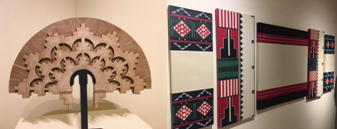Sometimes the Sermon Writes You
A Visit to the Poeh Cultural Center in Santa Fe, New Mexico with Stephen Tekaron-Hiarenkon Fadden
Rabbi Joel Seltzer, Executive Director of Camp Ramah in the Poconos, visited the Poeh Cultural Center in Santa Fe, New Mexico with Stephen Tekaron-Hiarenkon Fadden, the program director of the museum. During that visit, he saw the many ways in which the experiences of both Pueblo Native Americans and Jewish People can be compared. In his D’var Torah on Shabbat, April 21, he reflected on cherishing and transmitting a minority cultural identity in the context of the larger American homogeneity.
References:
Poeh Cultural Center Mission:
To be a gathering place for the respectful sustaining of Tewa traditions through being, doing and sharing.
Here, at the Poeh, old rhythms of life and ways of making beauty are still important. People bring beauty to the world on a pathway of being, doing and sharing called the Poeh. In the Tewa Pueblo language Poeh translates to “path” and the Poeh Cultural Center embodies that pathway, the essence of what it means to be a Tewa person – to be Pueblo.
Living as a Minority:
“As Native-Americans we are always ‘standing in two canoes;’ balancing our native-American cultures with the American culture that surrounds us. We must constantly balance ourselves with a foot in each of these canoes.”
“When I went to a white boarding school, my father told me, make friends with the Jewish kids, they understand what it means to be part of a tribe; they tell their story; they have not forgotten who they are.”
Authentic Cultural Art:

“When we speak of authentic cultural art it is important that we not confuse the medium an artist uses with the essential goal of cultural art. In Peublo culture, the essential goal of art is ‘adornment,’ although our artists today use media that our ancestors did not, their art is still authentic, in that it serves the larger and more important goal of adornment.”
Technology:
“Don’t confuse communication technology with communication.”
Story Telling:
“You can never tell your story enough. It must be repeated and repeated as often as possible.”
“Be careful that the stories you tell are your own, not someone else’s, and not stories that support someone else’s pocketbook.”
“When we think of storytelling, we often think of telling stories from the past to students of the present. But this is only 2/3rds of the impact of storytelling. Yes we tell stories of the past to the students of the present. But do not lose sight of the ultimate goal – the future. We tell stories to impact our future.”
Notes:
Between two skies = Shiyyur Bein HaArbayim; Bein HaShmashot
Poeh = Halakhah, the pathway. R. Danny Nevins – narrow enough to define community and culture, but wide enough to walk side by side with your partner.
Living in two Canoes – Jewish American or American Jew?
- Conflicts between the two canoes: Shabbat vs. political marches; competing Jewish values as well.
- In what ways are the narrative of the Jewish people similar/different to that of Native Americans? We tell our story of Galut from our homeland; their story is Galut IN THEIR HOMELAND!
- But we share the importance of storytelling; of remaining distinct in a world homogony.
- Authentic Cultural Art – Adornment = Hiddur Mitzvah; Jewish art as a vehicle for adorning ritual. Though the media have changed, our essential goal has not. Jewish art is the art of adorning the act of Jewish experience.
Technology – camp, I shared with Stevie after our tour that ALL of the camps represented have ‘no cell phone technologies.’ And while those policies were originally made in order to preserve our ‘no phone call home policies,’ now, and increasingly in the future these policies will become a raison d’etra of the summer camp experience.
- Do not confuse communication technology with communication. Studies have shown that after one month at summer camp, campers can better recognize emotional cues in the faces of their peers.
Storytelling:
- On the heels of Pesach, I was immediately drawn to Biblical precept – והגדת לבנך – And you shall teach this to your children.
- And concepts that the Seder ritual is our paradigmatic example of storytelling in each and every generation, בכל דור ודור, ‘in each and every generation’ and we can NEVER tell this story enough.
- The Buffalo Dance: Rikkud as sacred cultural transmission.
Our personal take-aways:
- We are people who stand in two canoes
- We are artists who attempt to use our art as a medium for adornment of our ritual and therefore our cultural continuity.
- We are storytellers and we CANNOT tell this story enough. And this story is told through art, and through dance, and through history, and we do this NOT to connect to the past – but to draw connections to the FUTURE!
- Halakhah, art, rikkud, hidur mitzvah, all of this – is a medium for cultural transmission.





